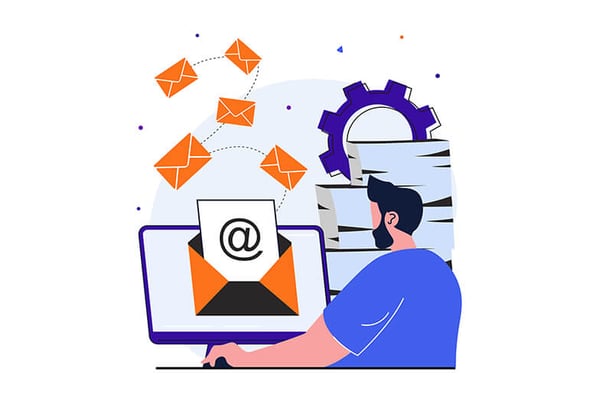How Can Email Marketing Fuel Your Overall Inbound Strategy?

In today's competitive digital landscape, understanding how email marketing can fuel your overall inbound strategy is essential for driving growth and generating leads. But you might be wondering, " How can email marketing fuel your overall inbound strategy? ". And " What does it mean to create an inbound email marketing strategy? ".
Well, I'm glad you asked.
Think of email marketing as the opposite of a pushy used car salesman.
It's all about creating valuable content that attracts new subscribers organically and then nurturing those leads through personalized emails.
The best part? Not only is email marketing cost-effective, but it also has a high return on investment compared to other channels.
And if you're not sure where to start... Don't worry; we've got you covered.
By the end of this article, you'll have all the know-how you need to craft compelling email campaigns, utilize personalization and automation tools, track your success, and keep your customers coming back for more.
Ready? Let's go!
Table of Contents

Segmenting Your Email List
Customer segmentation is a fantastic way of integrating email marketing into your inbound journey.
Why?
Because by breaking down your audience into small groups based on their unique characteristics, preferences, and behaviors, you can create targeted messages that will best help your customers.
This increases engagement rates and helps your current and potential customers feel like you actually know them.
Identifying Key Customer Demographics
Successful segmentation of your list starts with identifying customer demographics such as age, gender, location, or income level.
So, how exactly do you know who your customers are?
Through signup forms or surveys, you can get to know your customers better.
For example, as a digital marketing agency like Synarcon, imagine being able to reach small business owners in specific industries who are set on improving their online presence - the possibilities are endless!
Creating Experiences Tailored to Different Segments
Then once you've identified the different groups of people, the next step is providing valuable content specific to the sales funnel and their buyer's journey.
Not sure what to say?
Here's a list of options and their target audience:
- New subscribers: Send welcome emails that introduce them to your brand and show them the value they'll receive from being part of your mailing list.
- Loyal customers: Offer exclusive discounts or early access to new products/services as a token of appreciation for their continued support.
- Inactive subscribers: Re-engage them with personalized offers or content relevant to their initial interest in joining the list.
Crafting Compelling Emails
If you hate writing emails, chances are, your potential and existing customers will hate reading them...
So, if that's you, investing in a skilled copywriter might be a crucial aspect of finding success.
Writing Eye-catching Subject Lines
And once you've found yourself a word wizard...
The next step is creating eye-catching subject lines.
What does that look like?
It depends on your industry...
But generally, it's important to keep it short, relevant, and intriguing to pique the interest of your subscribers and existing customers.
For inspiration, check out these examples of effective subject lines.
Incorporating Strong Call-to-Action Buttons
Next is crafting strong call-to-actions.
And I can't stress this enough...
Call-to-actions are not pushy.
Call-to-actions are not sales-y.
CTA's are the lifeblood of conversions and increasing traffic.
Because a good call to action is what makes someone take action.
Without it, your audience won't know what to do next.
Not sure what to say?
Here are some call-to-action ideas you can incorporate into your email marketing strategy:
- Download our free guide now
- Claim your discount today
- Schedule a consultation with us
Personalization and Automation Tools
So now that you have your audience, your email addresses, and your CTA's, the next thing to do is personalize and automate your process.
Have you ever received an email that said, "Hey, friend.."
And then they tried to sell you something?
Yuck...
Instead of generic greetings, you want your subscribers to feel valued and understood.
How?
By personalizing their experience based on their preferences, their past interactions, and addressing them by name.
The best part?
By using automation tools for sending out welcome emails and nurturing leads, you can save time and effort!
And not only that, but automation ensures consistency in your brand image throughout the buyer's journey! So it won't feel like multiple salespeople talking to one current or potential customer.
Choosing the Right Automation Software
How do you automate your emails?
Check out these tools to get started:
A/B Testing for Optimization
And now that you know how to automate your emails, the next step is to track which ones are working...
Enter A/B testing.
A/B testing is a data-driven approach that involves creating different variations of specific elements within an email, such as subject lines or call-to-action buttons, and then analyzing which version performs better among your audience.
So basically, you can send out your emails and know which versions are working better than others.
With the data right in front of you, imagine never having to guess and check again!
Key Components to Test Within Emails
Here are some things you can test:
- Subject lines
- Call-to-action buttons
- Email content
- Sending times
Analyzing Results and Making Adjustments
After testing comes the fun part - analyzing!
By keeping an eye on open rates, CTRs, conversions, and unsubscribe rates, you gain valuable insights to refine your email marketing strategy throughout the buyer's journey.
Imagine this - you've created two emails with different subject lines.
One of them has a 70% open rate, while the other has a mere 30%.
What does that tell you?
Well, now you know the better subject line!
Exciting, right?
Growing Your Email List Strategically
Now that you have an amazing email marketing strategy, how do you get more people to subscribe?
Incorporate list growth strategies like opt-in forms on your website or social media platforms.
Effective Ways to Attract New Subscribers
Here are some examples of growth strategies for you to implement:
- Opt-in forms
- Social media promotions
- Email referral programs
- Landing pages
Cross-Promoting Between Digital Channels
And not only can you implement these forms, but you can also cross-promote your content between channels by publishing blog posts with embedded subscription forms or links directing readers toward a signup page.
Establishing Trust Through Valuable Content
By consistently providing informative and engaging content, email marketing can be used to build trust with your audience and demonstrate expertise in the industry without resorting to pushy outbound tactics.
This approach not only helps you demonstrate expertise in your industry but also encourages subscribers to make purchasing decisions when they're ready rather than resorting to pushy (sleazy) outbound marketing tactics.
Creating Engaging and Informative Newsletters
To create engaging newsletters, focus on delivering helpful information that addresses the needs of your target audience. Include tips, insights, and resources relevant to their interests while maintaining a casual tone of voice.
Demonstrating Industry Expertise
Here are some content ideas your target audience might enjoy:
- Actionable tips: Offer practical advice that readers can implement immediately.
- Educational content: Explain complex concepts in simple terms to enhance understanding.
- Trending News: Keep subscribers informed about current events related to their interests.
- In-depth case studies: Showcase real-life examples of success stories from clients or customers who have benefited from your products or services.
After demonstrating industry experience, the next step in leveraging email marketing is reactivating dormant customers.
Reactivating Dormant Customers
Have you ever signed up for a free eBook and then never returned to the website?
Email marketing offers the unique advantage of being able to reactivate dormant customers by sending targeted campaigns aimed at reigniting their interest in your products or services.
Strategies for Re-engaging Inactive Subscribers
Here are some strategies to re-engage your inactive subscribers with content marketing.
- Create a re-engagement campaign: Design a series of emails specifically tailored to win back inactive subscribers. Offer incentives such as discounts or exclusive content to entice them back into engaging with your business.
- Analyze past behavior: Use data from previous interactions to determine what type of content resonated most with these customers before they became inactive.
- Solicit feedback: Ask lapsed subscribers why they stopped engaging with your emails and use this information to improve future campaigns.
Crafting Personalized Messages for Reactivation
Reviving inactive patrons is a key component of email advertising, as it can assist in boosting profits and fostering consumer commitment.
Make sure you:
- Utilize customer data such as purchase history or browsing habits.
- Incorporate personalization techniques like dynamic content blocks based on subscriber attributes.
Monitoring and Evaluating Results
This next step is similar to A/B testing...
Meaning you never want to put effort into a marketing strategy without knowing the results.
Key Email Marketing Metrics to Track
Here's a list of things you should keep track of:
- Open rate: The percentage of recipients who opened your email. This metric helps gauge the effectiveness of your subject lines.
- Click-through rate (CTR): The percentage of recipients who clicked on a link within your email. A high CTR indicates that your content is engaging and relevant to subscribers.
- Conversion rate: The percentage of recipients who completed a desired action after clicking through from an email, such as making a purchase or signing up for an event. This metric directly measures the success of your campaign in driving results.
- Unsubscribe rate: The percentage of recipients who opted out from receiving future emails. Monitoring this metric helps identify potential issues with content quality or frequency.
Making Data-Driven Adjustments to Campaigns
And after you collect the data, the next step is to make changes.
For example, if CTRs are consistently low despite high open rates, reevaluate the relevance and value proposition offered within each message.
By regularly monitoring and evaluating results, you can maximize the impact of your marketing efforts on your overall inbound marketing strategies.
And that's it!
How Can Email Marketing Fuel Your Overall Inbound Strategy?
All in all, when you integrate email marketing into your inbound strategies, you can:
- Build trust through consistent value delivery.
- Reactivate dormant customers with targeted campaigns.
- Drive traffic to your website.
- Generate leads at a low cost.
Related Articles
Interestingly all the articles below have the same title. So only the names of the resources are listed;
